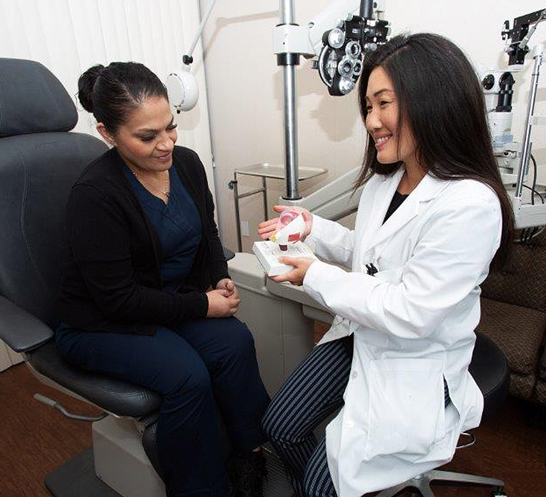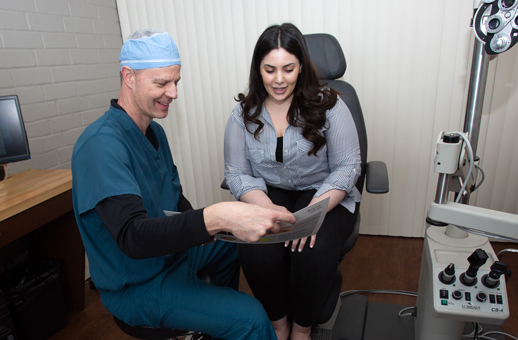Comprehensive Eye Care

Regular eye exams are an important tool in eye health by detecting and preventing eye diseases and evaluating the overall health of the patient. Some diseases, such as glaucoma, develop gradually without symptoms of pain or vision loss, so patients may not notice that anything is wrong until significant and irreversible damage has been done. Early detection of eye diseases allows for a choice of treatment options and a reduced risk of permanent damage. To learn more or to schedule your eye exam at Lynn Eye Medical Group, give our Thousand Oaks office a call today at (805) 495-0458! You can also reach our Westlake Village office by dialing (805) 496-6789!
A Regularly Scheduled Comprehensive Eye Examination
Pa tients should see their doctor for a comprehensive eye exam every year. Children should have regular tests to ensure the proper development of their vision and prevent any interference with academic achievements. Older adults are often at a higher risk for eye conditions such as glaucoma, macular degeneration, and cataracts. Even if eyes are healthy, a regular eye exam will provide the doctor with the ability to view the blood vessels of the eye. With the information obtained during an examination of the eyes, physicians have been able to detect chronic conditions such as high cholesterol, diabetes, and high blood pressure. The early detection of these conditions can lead to early treatment.
tients should see their doctor for a comprehensive eye exam every year. Children should have regular tests to ensure the proper development of their vision and prevent any interference with academic achievements. Older adults are often at a higher risk for eye conditions such as glaucoma, macular degeneration, and cataracts. Even if eyes are healthy, a regular eye exam will provide the doctor with the ability to view the blood vessels of the eye. With the information obtained during an examination of the eyes, physicians have been able to detect chronic conditions such as high cholesterol, diabetes, and high blood pressure. The early detection of these conditions can lead to early treatment.
How we perform our Eye Exams
An eye exam is different from a vision screening, which only tests vision and is commonly performed by a school nurse, pediatrician or other health care provider. Only an eye doctor can perform a comprehensive eye exam to evaluate the overall health of the eye and detect any changes that may indicate a vision disorder. During a routine eye exam, the doctor will evaluate the eyes for refractive errors, as well as common conditions such as:
- Amblyopia
- Strabismus
- Eye tracking
- Presbyopia
- Glaucoma
- Diabetic retinopathy
This is done through a series of eye tests that examine all aspects of the eye and may include:
- Visual field test
- Dilation
- Glaucoma test
- Slit-lamp examination
- Cover test
- Retinoscopy
- Refraction
These tests are performed in the doctor’s office and are safe for all patients.
What are my treatment options after my Eye Exams?
 After completing the comprehensive exam and coming to an accurate diagnosis, the doctor will develop a treatment plan based on the findings of the exam. This treatment plan may include:
After completing the comprehensive exam and coming to an accurate diagnosis, the doctor will develop a treatment plan based on the findings of the exam. This treatment plan may include:
- A prescription for eyeglasses or contact lenses
- Medication
- Vision therapy
- Eye vitamins
- Vision supplements
- Surgery
Patient testimonial
“Dr. Anya Sebring is fantastic as a pediatric ophthalmologist! My son is only 5 years old and has worn glasses since he was 2. Our previous ophthalmologist office had long wait times, and the doctor seemed impatient with my son when he struggled to comply with the exam, but he was only a toddler! I am SO grateful to have found Dr. Sebring and the Lynn Eye Medical Group after we moved to this area. The office staff is friendly, we never have to wait long to be seen for our appointment (sometimes within minutes of arriving), and Dr. Sebring is kind, patient, and works exceptionally well with my son in supporting him in completing his eye exams to the best of his ability!” – Melissa S.
Common Eye Conditions Found During a Comprehensive Eye Examination
The most common eye conditions diagnosed during a comprehensive eye exam involve refractive errors that cause blurry vision for patients. These conditions affect millions of people in the United States and often get progressively worse as patients age. Fortunately, refractive errors can be easily treated to let patients enjoy clear vision at all distances.
Myopia
Also known as nearsightedness or shortsightedness, myopia is a condition of the eyes in which nearby objects are clear and distant objects appear blurry. Almost a third of people in the United States experience some degree of nearsightedness.
Hyperopia
Also known as farsightedness, hyperopia is a condition of the eyes where the focus on distant objects is better than the focus on objects closer to the eye, so nearby objects appear blurry. The eye is designed to focus images directly on the surface of the retina; with hyperopia, light rays focus behind the surface of the retina, producing a blurry image.
Astigmatism
Astigmatism occurs when the cornea – the clear covering over the eye – is slightly irregular in shape, preventing light from focusing properly on the retina in the back of the eye. With astigmatism some of that light focuses either in front of or behind the retina, resulting in vision that may be blurry for either near or far vision or, for all objects.
All of these vision conditions can be effectively treated with either eyeglasses or contact lenses. Eyewear may be used during certain activities, such as watching television or driving, or at all times.
Schedule An Eye Exam At Our Thousand Oaks Office!
Do not hesitate to call (805) 495-0458 today to reach our Thousand Oaks office, or (805) 496-6789 for our Westlake Village office, and schedule your eye exam! You can also fill out the form on this page or our contact page, and our staff will help you set up an appointment with one of our experienced ophthalmologists.






